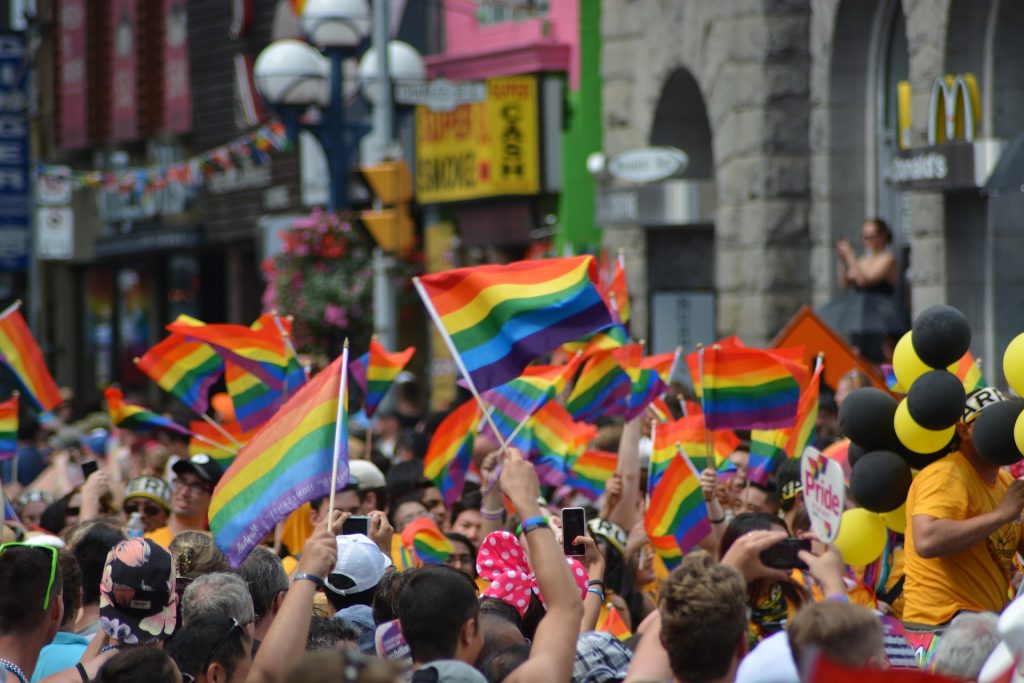By Smarnika Srivastava


The traditional norms of the Indian society cater to heteronormativity. This has been reflected in our larger attitude towards every conversation we tend to have about relationships or marriage. It is so deeply internalised that even our legal and judicial system follow it blindly as if there is no other possible reality.
There are several Indian religious laws, and a person can choose the law under which they want to get married. Unfortunately, these laws either have explicit mentions of heterosexual relationships by using connotations such as “husband”, “wife”, “man”, “woman” in conjunction with one another, or, the laws which are general have also been interpreted in a way which is only applicable to such relationships. The judiciary took a very long time to finally de-criminalise homosexuality through the landmark case of Navtej Johar v. Union Of India as late as in 2018, but sadly enough, the judgement does not do much in offering the same freedoms to same sex couples as it does to hetrosexual couples.
In India, through several cases Courts have held that the right to marry a person of one’s choice comes within the ambit of the right to life under Article 21 of the Constitution of India, 1950. The cases of Lata Singh v. State of Uttarpradesh (2006), Shafin Jahan v. K.M. Ashokan and Ors. (2018), and Shakti Vahini v. Union of India (2018), all recognise the freedom of choice of a woman to marry a man outside of her caste or religion. This very concept of the right to choose a partner for oneself is also seen taking shape in cases concerning same-sex relationships, such as Navtej Johar v. Union of India (2018), Madhubala v. State of Uttar Pradesh (2020) and Chinmayee Jena v. State of Orissa (2020).
Although there is a definite change in the attitude of the judiciary towards acceptance of the legitimacy of same sex relationships, which can be witnessed in some judgements passed in 2020 itself, where the fundamental rights of the same-sex couples have been recognised and they allowed to live-in with each other, there still is a long way to go in terms of their inclusivity in marriage laws. Marriage as a concept still remains to be heterosexual in India, hence, the outcome is that same-sex couples do not get a lot of benefits which heterosexual married couples get. This leaves the LGBTQ+ community still demanding for an equal status in the society.
International Scenario
As early as in 1967, the United States Supreme Court, in the case of Loving v. Virginia (1967)1, which struck down the ban on inter racial marriage, said that the freedom to marry is a personal right that should be available to all persons. It took many years for the United States to legitimise same-sex marriages, but finally, in 2015, in the case of Obergefell v. Hodges2), the US Supreme Court struck down all state bans on same-sex marriages and legalised same-sex marriages in 50 states.
By 2020, more than two dozen countries of the world have legalised same-sex marriages. Out of these, more than half counties are in Western Europe, including the United Kingdom, Netherlands, France and Spain. Other EU countries legally recognise civil unions which gives same-sex couples equivalent rights to married couples. Some examples of these countries include Italy, Greece and Switzerland.
In Asia, however, LGBTQ+ rights are limited. In 2019, Taiwan became the first Asian country where the Parliament as well as the Constitutional Court legalised same-sex marriages.. Other countries like Israel, Japan and Hong Kong follow egalitarianism with respect to relationships by providing benefits to same-sex couples such as spousal privileges. On the other hand, unfortunately, about 20 Asian countries including Saudi Arabia and United Arab Emirates still consider homosexuality as a crime. Afghanistan enacted a new Penal Code in February 2018 which explicitly criminalises same-sex conduct. Whereas the in Islamic Penal Code of Iran, homosexual intercourse can be declared as a capital offence, which means that violaters of the law would be meted out with death as a punishment.
Quick Recap: Steps taken in India
Draft Uniform Civil Code, 2017
A draft of Uniform Civil Code (“UCC”) was proposed in 2017 which defined marriage in a very wide manner, however, including the union between heterosexuals and homosexuals as well. It also defined partnership as living together of “any two persons”, thus giving some amount of legitimacy to live-in relationships between heterosexual couples as well as same-sex couples, without the burden of marriage. In many foreign countries, the idea of partnership or civil unions is recognised in order to give similar rights to same sex couples as those which come with marriages. Civil unions are arrangements that are legally recognised and are similar to marriage except the title of marriage itself in a way that the couple gets equal rights to that of a married couple such as the right to adoption, maintenance, inheritance etc. Though the UCC made way for the LGBTQ+ people to freely exercise their freedom of choice, there was no action taken upon it. They lost the opportunity to get an equal status legally, as well as in the society, thus, leaving them in the same oppressed conditions that they have been in since the longest time.
Constitutional Rights
From a constitutional law perspective, what can also be argued after the Navtej Johar judgement, is that there is no intelligible differentia that permits law to discriminate between homosexuals and heterosexuals since it is based solely on their sexual orientation. It is itself discriminatory that homosexuals are seen as different from heterosexuals in a way that they are made to live in less humane manner where they cannot even freely express their desires. The fact that they are seen as unequal is itself arbitrary, since apart from their sexual orientation, there is nothing that differentiates homosexuals from heterosexuals. Such an arbitrary discrimination leads to a denial of personhood and equal rights to that of heterosexuals. In furtherance of this, it can be argued that the state has to recognize their rights to choose a partner of their choice regardless of their gender, lest they would be discriminating arbitrarily against homosexuals.
Legalisation of Same Sex Marriages in India: Solutions
Given below are some solutions to push for the legalisation of same sex marriages in India. Firstly, introduction of a new law or an amendment to the already existing marriage laws can be done. In India, the majority of rights such as marriage, inheritance and adoption are governed by religious laws cannot be done away with and have been in practice by several communities for years. This is a major reason why the applicability of a Uniform Civil Code in India is still a highly debatable topic and seems off the radar for a long time to come. Therefore, the only feasible way for laws to be inclusive is by amending the Special Marriage Act, 1954. This Act is a secular marriage law in India and an amendment can be made to it to remove the assumption of heterosexual nature of marriages for it to be inclusive of gender identities and sexual orientation and remove words like husband and wife, man and woman, etc.3
Secondly, a Public Interest Litigation could be filed in the Supreme Court of India to legalize same sex marriages. The case can be strengthened by using relevant provisions of the Constitution of India, 1950, including Article 14 for right to equality and equal treatment, Article 15 for discrimination based on sexual orientation by taking the Navtej Johar case as a precedent, Article 19 for freedom to freely express their love and Article 21 for right to marriage as a fundamental right to life. There are many cases already being submitted to various High Courts, but PIL’s are the most effective way to raise issues of national and social importance.
Alternate Scenario: System of Civil Partnership
If in case same-sex marriages are refused to be recognised for times to come, a system of civil partnerships in India can also be demanded to be put in place so that LGBT+ couples get rights that are equal to that of heterosexual couples. Such a system of civil unions or partnerships will in turn make way for some new laws for same sex couples such as inheritance, adoption, etc. Civil unions or partnerships are considered to be equivalent to same-sex marriages in countries which have legalised it. Several European countries including the United Kingdom as well as South Africa have a system of civil-partnership in place. However, excluding the option of marriages and only providing civil-union rights to same-sex couples is itself discriminatory, since it provides the class of LGBTQ+ people an option which is considered to be lower than marriages. In India, even though the 2017 UCC tried to make the utopian dream of same-sex marriages or even the lesser alternative of civil-unions possible in the Indian legislative framework, it was completely disregarded, because of “constitutional protection extended to personal laws”. This is why India currently does not have any civil partnership system in place.
The way forward
The LGBTQ+ individuals are entitled to equality, freedom from discrimination and a right to have relationships with people of the same sex4 and also deserve to be given the same amount of legitimacy that heterosexual relationships. Just by merely decriminalising homosexuality, one cannot say that now people belonging to the LGBTQ+ community are at an equal footing to heterosexuals, since equality for them would not come about unless laws make way for spousal privileges for them, such as adoption, inheritance, maintenance etc. They have been treated in a very inhumane way and law has legitimised this oppression that is imposed on them by not taking any affirmative legislative action for protecting their interests. A true victory for same sex couples would only come about when they get equal rights to that of heterosexual couples and are placed at an equal footing without any arbitrary discrimination on the grounds of their sexual orientation alone. They must be treated equally in the eyes of law.
This is Part 2 of the two-part series on same- sex marriages which discusses about the International scenario with respect of same-sex marriages and how laws can be amended or introduced in India which are inclusive of LGTBQ+ community to provide them the equality that they long since deserve. Part I of the series discusses the attitude of the Indian society as well as the Indian legislative and judicial system on towards same sex marriages in India.
_____________
Smarnika Srivastava is a fourth year BA, LLB student at O.P. Jindal Global University. Views are personal.
- Loving v Virginia (1967) 388 U.S. 1, 12[↩]
- 576 U.S. 644 (2015[↩]
- Nayantara Ravichandan. Legal recognition of same-sex relationships in India, Manupatra India. Available at: http://docs.manupatra.in/newsline/articles/Upload/B07BDF52-0AA4-4881-96AC-C742B9DB217D.pdf[↩]
- Breda O’Brien. Modern Families, 25. Studies: An Irish Quarterly Review, 97, no. 385 (2008) Available at: http://www.jstor.org/stable/25660532.[↩]


